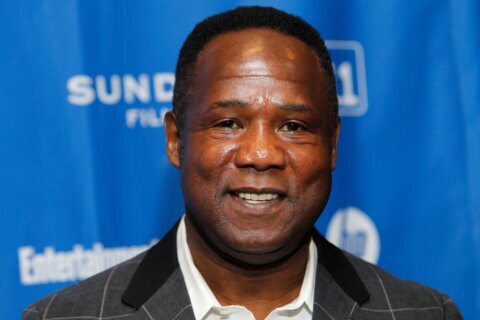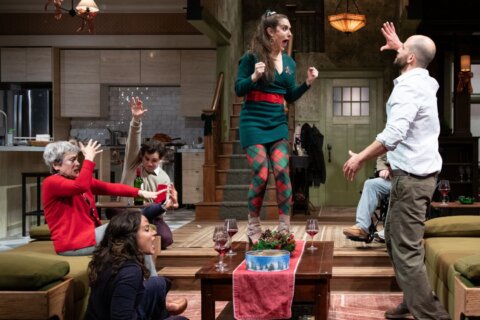The Kennedy Center is now presenting a powerful world premiere at its Family Theater.
Education Artist-in-Residence Jacqueline Woodson stages “Show Way” through May 29.
“‘Show Way’ is about seven generations of women and what they did to take care of the children that were coming after them,” Woodson told WTOP. “It’s based on my family’s history. It’s about perseverance and it’s about love. … A show way is a map that does that: shows the way. Back in the times of enslavement, people used them as secret codes.”
Woodson explores the real-life ancestors of her great grandmother, Soonie.
“When Soonie’s great grandma was 7, she was sold from the Virginia land to a plantation in South Carolina without her Ma or Pa, but some muslin that her Ma had given her and some needles that she got from the Big House and thread dyed bright red with berries from the choke cherry tree,” Woodson said. “The history of quilting and sewing as a means of survival.”
The story then spans seven generations down to Woodson’s own daughter.
“That’s what was fascinating, what my foremothers had to struggle through so that I could be here now writing,” Woodson said. “I wanted to understand how I got here as Jacqueline Woodson. I’ve written now 35 books, at that point 20, who was this kid who came from this history of people who were not even allowed to read and write to become this award-winning writer.”
She was also inspired to write the story to deal with personal grief.
“My grandmother died four months before I became pregnant with my daughter, Toshi, and I always wanted them to know each other, I wanted there to be a connection,” Woodson said. “Of course there’s that genealogical and biological connection, but I wanted Toshi to be able to pick up a book and see the journey and see how she’s connected to that journey.”
She first wrote “Show Way” as a children’s picture book in 2005. It became a John Newbery Medal Honor book in 2006 and was featured in the series finale of “Reading Rainbow.”
“I had my fabulous editor, Nancy Paulson, who I’ve worked with on many books,” Woodson said. “I wanted someone whose illustrations could move through time from collage to pencil drawings to paintings, watercolors and oils, I really wanted to get the textures of all those generations on the page. Hudson [Talbott] did an amazing job with the illustrations.”
How did it go from an acclaimed picture book to a stage musical?
“I never thought of it being something on stage … it wasn’t until I got to the Kennedy Center,” Woodson said. “My friend Toshi Reagon, who’s a musician, had always talked about the musicality of my writing. I thought, ‘What if it was a musical?’ … I worked with Tyrone Robinson on a very different version of ‘Show Way’ years ago. … I said, ‘Can you write all new songs?'”
Those songs make their world premiere at the Kennedy Center.
“One of the songs that I love is when they audience finds out the definition of a show way,” Woodson said. “It’s just such a beautiful number. We use the kora in it. The kora was the instrument that fathers taught their sons to play in Africa and it was passed down from father to son through the generations, then eventually women were playing it.”
It’s visualized for the stage by director Schele Williams, the first Black woman to do “Aida” on Broadway, as well as “M for Mandela” in London and “The Notebook” in Chicago.
“Once her hands touched the project, it became something of a dimension I had never imagined,” Woodson said. “Just seeing this work in progress brings tears to my eyes because it’s traveled so far from my head and at the same time is exactly where it’s supposed to be.”
What do we visually see on stage in the Family Theater?
“You’re seeing projections, you’re seeing what feels like puppetry but isn’t, it’s people behind a skrim moving,” Woodson said. “You’re seeing lots of great dancing, the choreographers are out of Howard University. … Lots of movement on stage in terms of backdrops and the magic of theater, people appearing and disappearing. … Lots of color, it’s like a quilt itself performing.”
Like the titular quilt, she wants her career to be a show way.
“I’m hoping that I am showing the way for other young people to tell their stories, to know that they have a story to tell, and a right to tell that story,” Woodson said. “I’m hoping that people who are experiencing my work, whether it’s on the page or on the stage, are understanding that what I’m saying them is, ‘Go off and tell your story, too.'”
Listen to our full conversation here.







